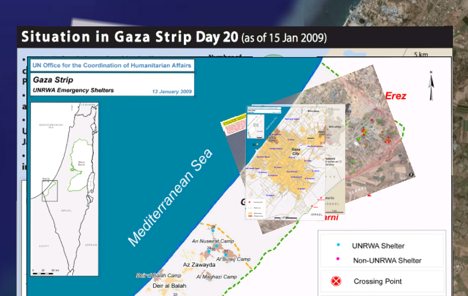Several new Gaza maps were released today, which I’ve added to the KML network layer for Gaza:
Three maps from the United Nations Office for the Coordination of Humanitarian Affairs (OCHA), posted to Reliefweb: A map of UNRWA emergency shelters, an updated situation map of Gaza that shows the UNRWA compound that was hit yesterday, and a map of Gaza City street names.
UNOSAT today released a new damage assessment map for the Gaza Strip, based on WorldView-1 satellite imagery taken on January 10. There is also a Gaza city closeup.

Both UNOSAT and Reliefweb have RSS feeds for the new maps they release each day, and ever since I subscribed two weeks ago I have been impressed by the constant updates — not just with maps of Gaza, but of floods in Colombia, weather forecasts in Afghanistan, fighting in Somalia, an earthquake in Costa Rica, cholera in Togo, Ebola in the DR Congo, piracy in the Gulf of Aden…
And yet, the result, always, is a PDF map, which is great for printing out but not any good for any other kind of use. In some cases, the PDFs are locked against everything but printing, which means taking screenshots in order to rasterize them for placement in Google Earth. The closed nature of these maps is especially ironic when it comes to the damage assessment map of UNOSAT: Every crater found on the satellite imagery is neatly covered by a colored rectangle — a censor couldn’t do a better job.
The solution, of course, would be to also release the information on these maps as vector-based objects on top of base layers of imagery. And KML would be the perfect open distribution format for this; you could just turn off the layer with crater placemarks and look for craters yourself if you wanted to.
An ideal solution: Given the global scope of these maps, their timeliness and usefulness, wouldn’t it be great if these were automatically published as KML to the Global Awareness default layer in Google Earth? People wouldn’t even need to go look for maps when they zoom in on a region hit by an emergency. The maps would be there, waiting for them.
[Update 10:45 UTC: Just to clarify, I’m not the first or the only one to lament the exclusive use of PDFs for these maps.]
It’s a bit of a hack, but in Windows, you could use PDFCreator to print that page to a TIFF/PNG/JPG file, with a user-defined DPI.
Great map! I wish to embed it in my blog. Thanks